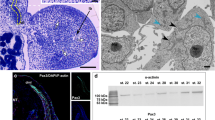Abstract
Monoclonal antibodies (MAbs) are used to investigate molecules that are expressed during embryonic muscle differentiation and that may be involved in muscle pioneer and muscle attachment site formation. MAb F2A5 immunoreactivity appears in all muscle pioneers as soon as they extend processes, and continues in all muscle precursors. MAb 4H1 immunoreactivity is strongly expressed only after mesodermal cells have fused with the muscle pioneers; then it is concentrated at their growth-cone-like ends near developing attachment sites. During later embryonic development, MAb F2A5 and MAb 4H1 immunoreactivity become associated with the myofibrillar network. Biochemical experiments indicate that MAb 4H1 recognises a 47 kDa antigen, and MAb F2A5 recognises an 80 kDa antigen.
Similar content being viewed by others
References
Albrecht FO (1953) The anatomy of the migratory locust. Athlone, London
Ball EE, Goodman CS (1985a) Muscle development in the grasshopper embryo: II. Syncytial origin of the extensor tibiae muscle pioneers. Dev Biol 111:399–416
Ball EE, Goodman CS (1985b) Muscle development in the grasshopper embryo. III. Sequential origin of the flexor muscle pioneers. Dev Biol 111: 417–424
Ball EE, Ho RK, Goodman CS (1985a) Development of neuromuscular specificity in the grasshopper embryo: guidance of motoneuron growth cones by muscle pioneers. J Neurosci 5:1808–1819
Ball EE, Ho RK, Goodman CS (1985b) Muscle development in the grasshopper embryo. I. Muscles, nerves, and apodemes in the metathoracic leg. Dev Biol 111:383–398
Bate M, Martinez-Arias A (1994) The development of Drosophila. Cold Spring Harbor Press, New York
Bentley D, Keshishian H, Shankland M, Toroian-Raymond A (1979) Quantitative staging of embryonic development of the grasshopper, Schistocerca nitens. J Embryol Exp Morphol 54:47–74
Bogaert T, Brown N, Wilcox M (1987) The Drosophila PS2 antigen is an invertebrate integrin that, like the fibronectin receptor, becomes localized to muscle attachments. Cell 51:929–940
Ho RK, Ball EE, Goodman CS (1983) Muscle pioneers: large mesodermal cells that erect a scaffold for developing muscles and motoneurones in grasshopper embryos. Nature 301:66–69
Jellies J (1990) Muscle assembly in simple systems. Trends Neurosci 13:126–131
Leptin M, Bogaert T, Lehman R, Wilcox M (1989) The function of PS integrins during Drosophila embryogenesis. Cell 56:401–408
MacKrell AJ, Blumberg B, Haynes SR, Fessler JH (1988) The lethal myospheroid gene of Drosophila encodes a membrane protein homologous to vertebrate integrin-β subunits. Proc Natl Acad Sci USA 85:2633–2637
Meier T, Therianos S, Zacharias D, Reichert H (1993) Developmental expression of TERM-1 glycoprotein on growth cones and terminal arbors of individual identified neurons in the grasshopper. J Neurosci 13:1498–1510
Myers CM, Ball EE (1987) Comparative development of the extensor and flexor tibiae muscles in the legs of the locust, Locusta migratoria. Development 101:351–361
Myers CM, Whitington PM, Ball EE (1990) Embryonic development of the innervation of the locust extensor tibiae muscle by identified neurons: formation and elimination of inappropriate axon branches. Dev Biol 137:194–206
Snodgrass RE (1929) The thoracic mechanism of a grasshopper and its antecedents. Smithson Misc Collect 82:1–111
Snodgrass RE (1931) Morphology of the insect abdomen. Smithson Misc Collect 85:1–128
Volk T (1992) A new member of the spectrin superfamily may participate in the formation of embryonic muscle attachments in Drosophila. Development 116:721–730
Volk T, Fessler LI, Fessler JH (1990) A role for integrin in the formation of sarcomeric cytoarchitecture. Cell 63:525–536
Whitington PM (1989) The early development of motor axon pathways in the locust embryo: the establishment of the segmental nerves in the thoracic ganglia. Development 105:715–721
Williams GJA, Caveney S (1980a) Changing muscle patterns in a segmental epidermal field. J Embryol Exp Morphol 58:13–33
Williams GJA, Caveney S (1980b) A gradient of morphogenetic information involved in muscle patterning. J Embryol Exp Morphol 58:35–61
Xie F, Meier T, Reichert H (1992) Embryonic development of muscle patterns in the body wall of the grasshopper. Roux's Arch Dev Biol 201:301–311
Author information
Authors and Affiliations
Rights and permissions
About this article
Cite this article
Xie, F., Garzino, V., Therianos, S. et al. Embryonic expression of muscle-specific antigens in the grasshopper Schistocerca gregaria . Roux's Arch Dev Biol 204, 141–145 (1994). https://doi.org/10.1007/BF00361108
Received:
Accepted:
Issue Date:
DOI: https://doi.org/10.1007/BF00361108




